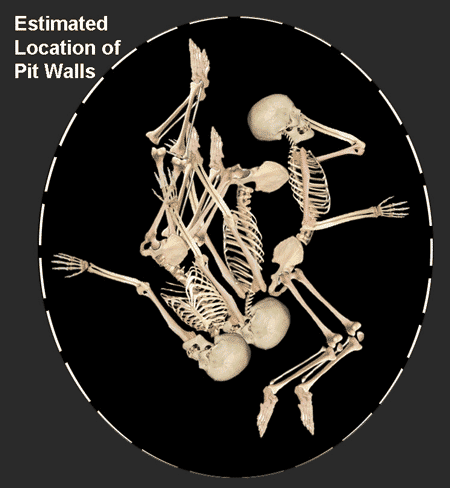Blake de Pastino
Source - http://westerndigs.org/mass-grave-of-prodigal-sons-in-california-poses-prehistoric-mystery/
New research has turned up some perplexing clues in a prehistoric mystery: the fate of three men found in a mass grave in California, their bodies riddled with arrow points and dumped in a pit some 560 years ago.
Their violent deaths came at a tumultuous time in Central California, archaeologists say, as bands were vying brutally for territory and resources.

A digitized image shows the positions of three 15th-century men found in a mass grave in central California. (Courtesy Jelmer Eerkens)
Indeed, the archaeological record from the period is rife with evidence of hand-to-hand combat: fractured skulls, broken arms, even body parts taken as trophies.
But the new clues, uncovered by anthropologists at the University of California Davis, don’t have anything to do with who killed the men, or why. Instead, they’re shedding light on where the men were from.
And the results — revealed in the chemistry of the victims’ teeth and bones — show that they were something like prodigal sons: born and raised in the same region where they were buried, but having spent most of their adult lives far away.
Unlike the Lost Son of the Biblical parable, however, these men were not feted when they returned. Instead, they were killed.
“It’s more or less a case of ancient forensics: Who were these men?” said Dr. Jelmer Eerkens, a UC Davis anthropologist who led the new research into the killings.
“We had expected them to be from somewhere else, and ultimately they were. But for us, the interesting thing was that while they lived as adults somewhere else, as children, they were from the area where they were killed.
“So that opens up a whole set of new questions surrounding the circumstances of their death.”
The victims were first discovered by a farmer in 1964, buried in a mound on a floodplain of the Sacramento River in Yolo County, about 100 kilometers northeast of San Francisco.
Anthropologists called in from Davis found four bodies in the pit and excavated three of them. The men had been interred in mass-grave fashion, without being placed in a traditional, flexed position and without any grave goods.
And all of them had suffered obvious physical trauma: Each had at least three, and in one case as many as seven, loose arrow points still in his rib cage; and in two of the men, obsidian points were still embedded in their spines.
The remains languished in museum storage without much study until about 10 years ago. Then Eerkens and his team, armed with new technology, sought to reconstruct the life stories of these men, to “help archaeologists better understand the nature of ancient warfare and interpersonal conflict,” the team writes in the latest issue of the Journal of Archaeological Science.
One way of uncovering who these men were, the researchers decided, was to study the chemistry of their teeth and bones in order to find out where they’d been.
The method they used is called isotope analysis. For example, in soil, the element strontium occurs in different variations, or isotopes, at ratios that are unique to every region, dictated by the age and chemistry of the local landscape. So when people eat plants, or animals that ate those plants, from that region, the local levels of strontium become stored in their teeth and bones.
A similar phenomenon occurs with the oxygen in water. Water supplies in different areas contain unique concentrations of oxygen isotopes, which vary from place to place. Those chemical signatures, too, become taken up permanently by human tissues, particularly teeth. So by studying a tooth’s many layers, scientists can track a person’s whereabouts throughout their lifetimes, often all the way back to infancy.
In the case of the three Yolo bodies, Eerkens’ team used mass spectroscopy to detect levels of these isotopes in their teeth and bones, thereby getting a sense of their migrations.
The researchers found that two of the three victims were born and raised, and all three lived their teenage years, near the site where they were buried, on the Sacramento floodplain.
But as adults, the isotopes in their teeth show that they lived elsewhere, probably to the north along the Sacramento River.
And according to radiocarbon dates, they died around the year 1450, after they had returned to the territory of their childhood and were killed.
The scientists had expected more straightforward results, they said — that either the men would turn out to be lifelong locals, suggesting that they died defending their territory, or they would be foreign invaders.
But the data, they write, “suggest a much more nuanced scenario.”
Of course, the data provide no insights into why these peripatetic men were killed, or why they ever left. The team can only conclude that for some reason, they were “not welcome” when they returned “and were treated as enemies.”
In any event, Eerkens tells Western Digs, the new findings suggest that the hunter-gatherers of Central California may have been more mobile than had been thought. Plus, the study shows how bone and tooth chemistry can illustrate those migrations centuries later, and possibly help us understand the nature of prehistoric conflict.
“Basically, the article is interesting because we can use modern scientific methods, stable isotope analysis, to figure out where these victims of violence are from,” Eerkens said.
“We’ll also be working with the DNA in the future, to see if we can figure out how they are related to one another.”
Jelmer W. Eerkens, Gry Barfod, Gina Jorgenson, & Chris Peske (2013). Tracing the mobility of individuals using stable isotope signatures in biological tissues: “locals” and “non-locals” in an ancient case of violent death from Central California Journal of Archaeological Science DOI: 10.1016/j.jas.2013.09.014